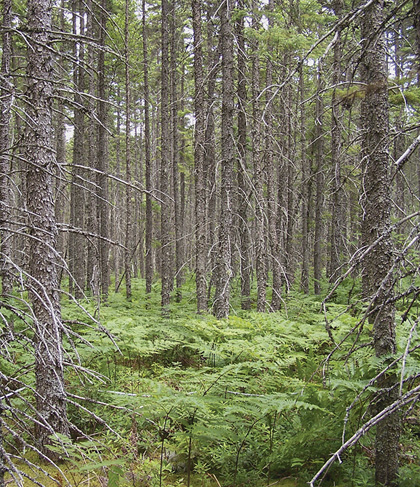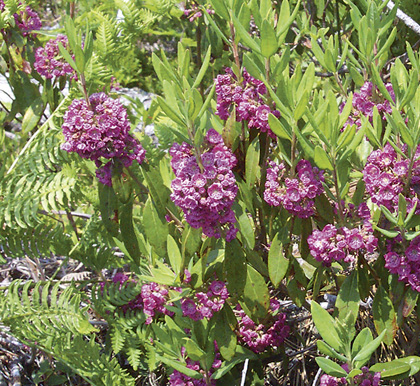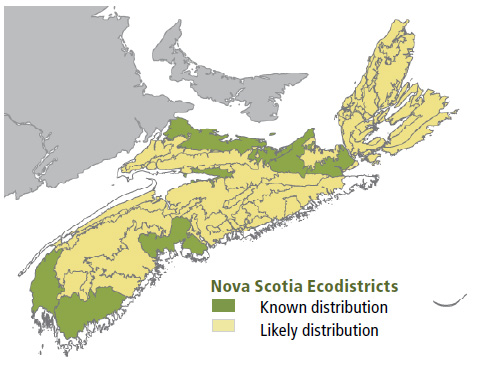
Forest Vegetation types - SP5
SP5 — Black spruce / Lambkill / Bracken
Picea mariana / Kalmia angustifolium / Pteridium aquilinum
 |
Jersey, Cumberland County |
Concept: This early to late successional Vegetation Type (VT) has a coniferous tree canopy dominated by black spruce and a well-developed woody shrub layer. Black spruce / Lambkill / Bracken usually follows stand-replacing disturbance such as fire, windthrow or harvesting.
Vegetation: Black spruce is the dominant overstory tree with lesser balsam fir. Hybrid (red/black) spruce may also form a significant portion of the canopy. Red maple, white birch, white pine and tamarack are scattered throughout some stands. The shrub layer is dominated by balsam fir and black spruce with lesser red maple. Other characteristic species include wild raisin, lambkill, velvet-leaf blueberry and false holly. Herb and bryophyte diversity is generally low, with bracken the most common herb and smaller amounts of pink lady's slipper, cow-wheat and teaberry. Schreber's moss, wavy dicranum and stair-step moss usually dominate the bryophyte layer. The presence of creeping snowberry, cinnamon fern, stair-step moss and patches of sphagnum moss indicate elevated moisture levels.
Environmental Setting:SP5 is associated with fresh to moist, nutrient poor soils. Thick, ericaceous duff layers are common which limit regeneration by seed unless disturbance creates more exposed micro-sites. Without disturbance, black spruce regeneration is usually by vegetative layering. This VT can be found throughout Nova Scotia on a variety of soils with low nutrient status. This VT is widespread and common across the Maritime Provinces.
Successional Dynamics: Nutrient poor soils associated with this VT lead to an edaphic climax community dominated by black spruce. Historically SP5 stands originated from fire disturbance creating mainly even-aged stands. With less frequent disturbance events, white pine may become more prominent in the overstory, possibly leading to a SP4 (White pine / Blueberry / Bracken) community. White pine may also develop a super canopy overtopping an even-aged forest condition of black spruce. SP5 is the successional endpoint for many VTs in the SP group.
Ecological Features: The canopy of this large-patch and sometimes matrix forest can be closed or open depending on past disturbances and site conditions. Excessive surface stoniness is common for this vegetation type, limiting the extent of canopy development. Black spruce has intermediate shade tolerance and does not seed well under closed canopies. Vegetative regeneration by layering is common in black spruce, especially on sites where there is a thick duff layer and adequate soil moisture. The accumulation of spruce and pine needles on the ground results in a poorly-developed humus layer and impoverished soil fauna. Spruce grouse eat conifer needles in winter and may be found in this habitat. Dwarf mistletoe sometimes creates dense witches brooms that are important nest and rest areas for small mammals. Mature forests develop abundant old man's beard, a lichen, sought for nest material by northern parula warblers and other species, and for winter food by deer foraging on fallen trees.
 |
| Lambkill |
Distinguishing Features: This softwood forest of black spruce is found on poor, dry to fresh-moist soils. Most shrubs and herbs represent these site conditions, but in moist depressions small patches of sphagnum, creeping snowberry and cinnamon fern are present.
| Slope Position: | Level4 Upper4 Crest1 Middle1 |
Surface Stoniness: |
(Non - Slightly)7 (Moderately)2 (Very - Excessively)1 |
Bedrock Outcrop: |
(Non-rocky)7 (Very - Excessively)2 (Slightly - Moderately)1 |
Elevation Range: |
20 - 232m |
Slope Gradient: |
Level4 Gentle4 Moderate1 nd1 |
Aspect: |
North2 East1 South1 West1 None5 |
Exposure: |
Moderate7 Mod. exposed2 Exposed1 |
Microtopography: |
Level5 Slightly3 Moderately2 |
Drainage: |
Moderately well3 Rapid3 Well3 Imperfect1 |
Soil Type: |
ST13 ST23 ST152 ST2-L1 ST61 |
Parent Material: |
Glacial till6 Glaciofluvial3 Till/Bedrock1 |
Rooting Depth (cm): |
(<30)2 (30-45)4 (>45)3 nd1 |
Duff Thickness (cm): |
(0-5)1 (6-10)2 (11-20)5 (21-40)1 nd1 |

